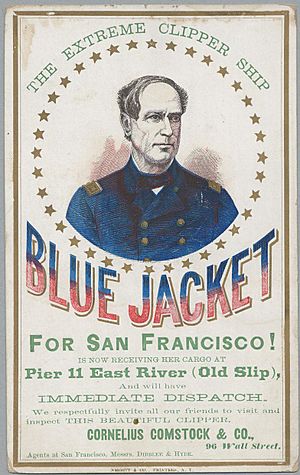Blue Jacket (clipper) facts for kids
 |
|
Quick facts for kids History |
|
|---|---|
| Owner | Seccomb & Taylor, Boston ; Sold to John Frost for his Fox Line of Australian packets later that year. |
| Builder | Robert E. Jackson, East Boston, MA |
| Launched | August 7, 1854 or Aug. 27, 1854 |
| Fate | Caught fire and sank March 5, 1869 |
| General characteristics | |
| Class and type | Medium clipper |
| Tons burthen | 1790 tons |
| Length | 220 ft (67 m). ; 235 ft (72 m). LOA |
| Beam | 41 ft 2 in (12.55 m), or 41 ft. 6 in. |
| Draft | 24 ft (7.3 m). |
| Notes | 2 decks |
The Blue Jacket was a very fast sailing ship, called a medium clipper, built in 1854. It was famous for how fancy and decorated its rooms were. The ship sailed on important trade routes between Liverpool, England, and Australia. The name Blue Jacket came from the traditional name for sailors in the US and British navies.
Contents
The Ship's Figurehead
A figurehead is a carved statue at the front of a sailing ship. The Blue Jacket's figurehead was a man. He was shown from the waist up, dressed like an old sailor. He wore a blue jacket with yellow buttons, which was open in the front. He also had a loose shirt and a large knotted handkerchief around his neck.
How the Ship Was Built
The Blue Jacket was designed to be strong and carry a lot of cargo. It had a sharp front part (bow) and a wide middle section. This design made the ship look powerful. It was a common style for ships built by Donald McKay, a famous ship designer.
The main structure of the Blue Jacket was made from strong white oak wood. Its outer layers and inside walls were made of hard pine. The ship was also strengthened with iron braces and securely fastened together.
The inside of the ship was very elegant. A magazine from that time, the U.S. Nautical Magazine, described it: The ship had two main cabins under its back deck. The main saloon was 40 feet long and 14 feet wide. It was painted white and decorated with fancy gold designs made from papier-mâché. Each decorated section had pictures of flowers, fruit, and animals. This saloon had 20 private rooms, called state-rooms. They were well-ventilated and finished in a very high-quality way. Each room had different furniture, carpets, and curtains. They also had a square window on the side and skylights above.
The back cabin, or ladies' cabin, was 30 feet long and 13 feet wide. It had eight state-rooms and even a bathroom. This cabin was like a tiny palace! It had walls made of shiny mahogany wood. The decorative parts were made of rosewood, and the support pillars were made of satinwood. The wall panels were decorated with flowers and fancy gold patterns.
Important Journeys
The Blue Jacket was used by the White Star Line, a famous shipping company, in 1854. It made several important voyages:
- From Boston, USA, to Liverpool, England.
- In 1854, Captain Eldridge sailed this trip in just 12 days and 10 hours.
- From Liverpool, England, to Melbourne, Australia.
- In 1855, Captain Underwood completed this journey in 68 or 69 days.
- From Madras, India, to London, England.
- This trip took 92 days in 1855.
- From Lyttelton, New Zealand, to London, England.
- In 1863, Captain James White made this trip in 63 days.
- From San Francisco, USA, to Honolulu, Hawaii.
- In 1865–1866, Captain Dillingham sailed here to pick up whale oil for New Bedford, USA. This trip took 14 days.
The Ship's Final Voyage
The Blue Jacket left Lyttelton, New Zealand, carrying various goods, including flax. On March 5, 1869, while sailing near the Falkland Islands, the flax cargo caught fire. Four days later, on March 9, the crew had to leave the burning ship. On March 16, another ship, the Pyrmont from Hamburg, Germany, rescued the crew. Nine people survived, and they even managed to save 15,000 pounds sterling worth of gold from the ship.
Finding the Figurehead Again
After the ship was lost, something amazing happened. The figurehead of the Blue Jacket was found washed up on the shore of Rottnest Island, which is off the coast of Fremantle, Western Australia.
The figurehead appeared on the beach 21 months after the ship burned. This was about 6,000 miles (9,656 km) from where the Blue Jacket sank. Scientists calculated that the figurehead drifted about 6½ miles (10.5 km) each day to reach the island.
See also
- List of clipper ships

